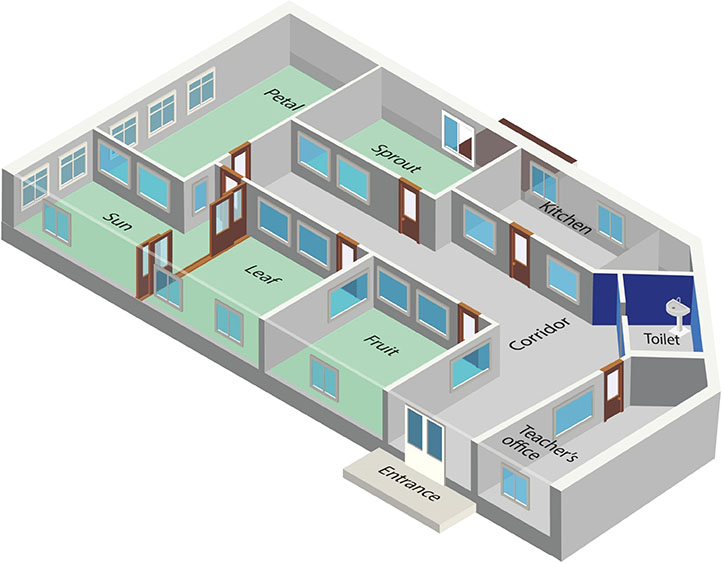Infect Chemother.
2019 Jun;51(2):171-176. 10.3947/ic.2019.51.2.171.
Norovirus Outbreak in a Kindergarten: Human to Human Transmission among Children
- Affiliations
-
- 1Department of Epidemiology and Health Informatics, Graduate School of Public Health, Korea University, Seoul, Korea. gentryu@onehealth.or.kr
- 2Division of Infectious Disease Control, Gyeonggi Provincial Government, Suwon, Korea.
- 3WHO Collaborating Centre for Infectious Disease Epidemiology and Control, School of Public Health, Li Ka Shing Faculty of Medicine, The University of Hong Kong, Hong Kong Special Administrative Region, China.
- 4Team of Infectious Disease Control, Sungnam City's Department of Public Health, Sungnam, Korea.
- KMID: 2450873
- DOI: http://doi.org/10.3947/ic.2019.51.2.171
Abstract
- An outbreak of acute gastroenteritis was reported from a kindergarten on January 5, 2018 and investigation was conducted. A case was defined as a kindergartener presented with vomiting or diarrhea twice a day between January 1 and January 5, 2018. All kindergarteners were interviewed to identify the factor associated with case development. Fifteen (31.3%) children of a total of 48 were identified as cases, and four were confirmed to be Group II, Norovirus positive. In our study, based on the pattern of epidemic curve and different attack rate by classroom in a kindergarten, Norovirus was likely transmitted from human to human.
Keyword
Figure
Reference
-
1. Hall AJ, Vinjé J, Lopman B, Park GW, Yen C, Grecoricus N, Parashar U. Updated norovirus outbreak management and disease prevention guidelines. MMWR Recomm Rep. 2011; 60:1–15.2. Mattner F, Sohr D, Heim A, Gastmeier P, Vennema H, Koopmans M. Risk groups for clinical complications of norovirus infections: an outbreak investigation. Clin Microbiol Infect. 2006; 12:69–74.
Article3. Lopman B, Vennema H, Kohli E, Pothier P, Sanchez A, Negredo A, Buesa J, Schreier E, Reacher M, Brown D, Gray J, Iturriza M, Gallimore C, Bottiger B, Hedlund KO, Torvén M, von Bonsdorff CH, Maunula L, Poljsak-Prijatelj M, Zimsek J, Reuter G, Szücs G, Melegh B, Svennson L, van Duijnhoven Y, Koopmans M. Increase in viral gastroenteritis outbreaks in Europe and epidemic spread of new norovirus variant. Lancet. 2004; 363:682–688.
Article4. Vivancos R, Shroufi A, Sillis M, Aird H, Gallimore CI, Myers L, Mahgoub H, Nair P. Food-related norovirus outbreak among people attending two barbeques: epidemiological, virological, and environmental investigation. Int J Infect Dis. 2009; 13:629–635.
Article5. Centers for Disease Control and Prevention (CDC). Norovirus outbreak associated with ill food-service workers--Michigan, January-February 2006. MMWR Morb Mortal Wkly Rep. 2007; 56:1212–1216.6. Korea Centers for Disease Control and Prevention (KCDC). Guideline for the laboratory diagnosis for national notifiable infectious disease, 2016. Accessed May 24, 2019. Available at: http://www.cdc.go.kr/CDC/cms/cmsFileDownload.jsp?fid=51&cid=138126&fieldName=attach1&index=1.7. Nam SJ, Park PH, Bang SJ, Huh JW, Yun HJ, Park KH, Yoon MH. Molecular epidemiological study of norovirus gastroenteritis outreaks in Gyeonggi-Do from 2014 to 2015. Korean J Microbiol. 2018; 54:24–30.8. Tao Z, Xu M, Lin X, Wang H, Song L, Wang S, Zhou N, Zhang D, Xu A. Environmental surveillance of genogroup I and II noroviruses in Shandong province, China in 2013. Sci Rep. 2015; 5:17444.
Article9. Ham H, Oh S, Seung H, Jang J, Han C. Human norovirus genogroups detected from acute gastroenteritis patients in Seoul from May 2013 to April 2015. J Bacteriol Virol. 2015; 45:376–381.
Article10. Xue Y, Pan H, Hu J, Wu H, Li J, Xiao W, Zhang X, Yuan Z, Wu F. Epidemiology of norovirus infections among diarrhea outpatients in a diarrhea surveillance system in Shanghai, China: a cross-sectional study. BMC Infect Dis. 2015; 15:183.
Article11. Centers for Disease Control and Prevention. Norovirus. Centers for Disease Control and Prevention;Accessed July 9, 2018. Available at: https://www.cdc.gov/norovirus.12. Korea Centers for Disease Control and Prevention (KCDC). Guideline for waterborne & foodborne diseases prevention and control, 2018. Accessed May 24, 2019. Available at: http://www.cdc.go.kr/CDC/cms/cmsFileSeDownload.jsp?fid=10713&cid=137994&fieldName=attach1&index=1&fk=b6cc56cb8ca79df52ace1fd84611f68636756571ab43ffb4c771721a3b2151d6.13. Atmar RL, Opekun AR, Gilger MA, Estes MK, Crawford SE, Neill FH, Graham DY. Norwalk virus shedding after experimental human infection. Emerg Infect Dis. 2008; 14:1553–1557.
Article
- Full Text Links
- Actions
-
Cited
- CITED
-
- Close
- Share
- Similar articles
-
- Emergence of Norovirus GII.17-associated Outbreak and Sporadic Cases in Korea from 2014 to 2015
- Effectiveness of Norovirus Outbreak Management Protocol for Controlling Outbreak of Norovirus in Pediatric Wards
- Investigation of Scarlet Fever Outbreak in a Kindergarten
- Molecular Characterization of Norovirus and Rotavirus in Outbreak of Acute Gastroenteritis in Seoul
- Human Norovirus Genogroups Detected from Acute Gastroenteritis Patients in Seoul from May 2013 to April 2015



